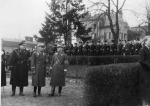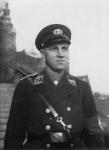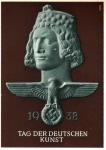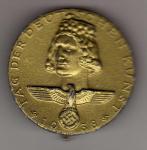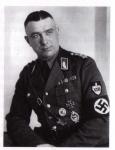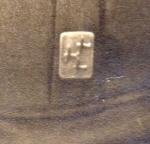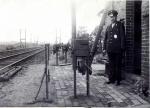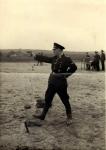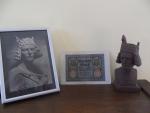-
Posts
2,143 -
Joined
-
Last visited
-
Days Won
10
Content Type
Profiles
Forums
Blogs
Gallery
Events
Store
Everything posted by Odulf
-
Larry, I think that the reason is not about the role of the Reichsbahn but the availability of information about RB uniforms. The same applies to e.g. Reichspost, Organisation Todt, NS-Frauenschaft, Red Cross and many other uniformed organisations. Good research books, when available, are expensive and collectors with a small purse rather buy pieces for their collection instead of investing in building a reference library; also because it is possible to put all questions on forums. Some more RB photos from the early 1930s.
-

Uncategorised Der Bamberger Reiter
Odulf replied to Odulf's topic in Non Military Collectibles & Antiques
The Bamberger Reiter was also selected to be the "face" of the TAG DER DEUTSCHEN KUNST (Day of the German Art) in 1938. -
Recently I received this portrait. On the back is written: Arbeitsgau XVIII Niedersachsen-Ost, Dr. Wagner??? Friedrich Schröder ? I doubt if it is Dr. Wagner, but I also doubt Dr. Fritz Schröder... I also doubt if it is a Generalarbeitsführer and I am inclined to think he is a (Ober-/Oberst-) Arbeitsführer. Does any one recognise this face?
-
I have found it It is a Winterhilfswerk broach of the Reichsluftschutzbund. There is a magnificent complete collection of all the WHW Spendeabzeichen (donation badges) at the website of Hermann Historica (Lot Nr. 8362) http://www.hermann-historica.de/auktion/hhm64.pl?db=kat64_WHW.txt&f=ZAEHLER&c=0&t=temartic_W_GB&co=6
-
For some time I have this puzzle, a small (5.5 x 5.5) photo, with 3 men: left a Major (Bat. Cdr.?), centre a Unteroffizier with RK, right a Oberleutnant (Comp. Kdr.?). All men are wearing the Infantry Assault Badge in silver, and both officers have a 3 digit number on their shoulderboards. Hence, the Unteroffizier must be an Infantryman, in the first half of the war (because the regimental numbers on the shoulderboards became obsolete in about 1942). When I purchased the photo, some one wrote in pencil on the back Willi Lücke (this is incorrect, but Willi Lüke was a Pioneer Uffz. who won the RK on 16-11-44). Below I will show the photo and a detail of the Lieutenants shoulderboard, and a pucture of the reverse. The photo was removed from an album, and as much of possible of the glue and paper has been removed. Can any one decypher the text, because this will reveal the name of the Unteroffizier? Your help is very much appreciated!
-
On a cap/hat it is worn over the left ear, but it was also worn by Bavarian units on the (right) collar (tab). This is NOT the type of Edelweiss worn by the Gebirgsjäger (Mountain troops) but by the SA, HJ, RAD, and other uniformed organisations. Please note that this badge has been used from the beginning of the 20th century until now, without much change in the design or material. It is sewn on with a few stitches in 4 or 5 places.
-
Leopold Carl Edward George Albert, Archduke of Saxe Coburg & Gotha, Prince of Great Brittain and Ireland, Count of Jülich, Cleve and Berg, Engern and Westphalia, etc. etc. (born19 Juli 1884, died 28 March 1953), son of Prince Leopold Duc of Albany, Lieutenant-General of Prussia a la suite [source: Almanach de Gotha, 1914]. He was a British born grandson of Queen Victoria. http://en.wikipedia.org/wiki/Charles_Edward,_Duke_of_Saxe-Coburg_and_Gotha
-
The Bamberger Reiter (Bamberg Horseman) is a beautiful stone realistic life size sculpture from the first half of the 13th century, in the cathedral of Bamberg (Germany). Throughout times there has been much speculation about his identy. The characteristic head of the statue was depicted on the 1920 German banknote of 100 Reichsmark, and it became an icon of the Aryan man. Never the less, the Bamberger Reiter was also shown on the German 2 Euro stamp of 2003. To the German people in 1920, 100 Mark was a lot of money and a 100 Mark bill was the backbone of financial traffic. So to my opinion the well known face of the Bamberg Reiter was also an encouragement to the German people, after a bloody war and a humiliating peace. But it also turned out to be the up step to an inflation without precedent! Ever since I visited Bamberg Cathedral first (1972) I have been impressed by the cool distant dignity of this noble horseman and the realistic features of his horse, and in many ways this sculpture represents the rich history of Germany. Next photos are from my collection.
-
The Kölnische Illustrierte Zeitung of 4 November 1943 gives some very interesting information regarding Otto Lancelle (see my post at #107). The Polish town of Rzgow was renamed Lancellenstädt to commemorate the German Army General, and division commander, Lancelle. Rzgow lay near the larger town Lotz. Lotz was renamed Litzmannstadt in honour of the German Gerneral Litzmann who was active in the region during the 1st World War (the Germans created a arge Jewish getto in the town). But other places in the new German province Wartheland were also renamed. Thus, Kutno became Quadenstadt in rememberance of SA-Obergruppenführer Joachim Meyer-Quade who was KIA as an Infantry lieutenant (10-9-39) near the town when the German army attacked Poland in September 1939. Brzezney was renamed Löwenstadt, in commemoration of General Litzmann who fought a decisive battle near the town which gave him the nickname "Lion of Brzezney".
-

Uncategorised Another Fanfare
Odulf replied to Jock Auld's topic in Germany: Third Reich: Uniforms, Headwear, Insignia & Equipment
-

Uncategorised Another Fanfare
Odulf replied to Jock Auld's topic in Germany: Third Reich: Uniforms, Headwear, Insignia & Equipment
It is not unusual that these instruments are unmarked when used by HJ, DJ, DAF, or other organisations. On many occasions they were owned by the musician, or they were bought from private stores and suppliers by the Bann, Jungschaft, or what else. Also, these fanfares were used by many other organisations such as Scouts, Christian or Catholic youth groups, Communist or Socialist (uniformed) youth formations, etc. The same applies to wooden kettle Landsknecht drums with black or red flames on a white kettle, they are still in use to day (the only difference is a modern skin instead of an organic skin).





